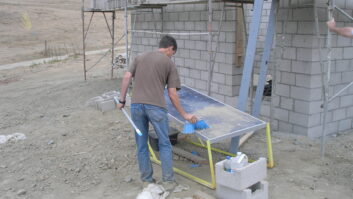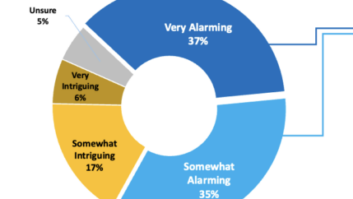BOLZANO, ITALY — While it is common for a transmitter site to be located on the top of a mountain, it’s less common for one to be found underground.

The Plan de Corones transmitting site is just that —located underground. It is situated on the eponymous mountain plateau in the Italian province of South Tyrol in the Alps, an area that once hosted many small lattice towers for TV, radio, telephony and emergency rescue services.
From the RF planning point of view, the Plan de Corones site benefits from a strategic location and can easily serve the more than 25,000 people living in the surrounding valleys.
SINGLE SITE
At first glance, located 2,265 meters (7,430 feet) above sea level with some 100 assorted antennas covering one 80-meter (260-foot) mast and no building in sight, one might imagine that they are seeing a high-altitude monument to broadcasting.

“About 20 years ago, the South Tyrol Council envisioned a single, high-end, transmitting facility to group together each existing separate transmitting location,” said Daniel Largher, civil infrastructure manager at RAS, which stands for Radiotelevisione Azienda Speciale (Rundfunk-Anstalt Südtirol in German), South Tyrol’s public service broadcaster.
The idea was to offer to any operator hosting services at a competitive rate, according to a publicly available price list, and to streamline operation while reducing the impact on the site’s surroundings. The first step was to select a popular tourism location and get feedback from the market about this prospective project. The council chose Masi della Muta, near Merano, where more than 30 small lattices were spread throughout the petite plateau. In 1996 it then commissioned the RAS to design and construct a transmission facility to be shared among the various operators.
The Plan de Corones site is so carefully designed and built, including RF coverage and operation reliability, that most operators in the area found the new site to be a better alternative to any of the existing “basic” individual sites.

“The new site proved that a publicly-owned entity could hit the mark. Now at Masi della Muta there is just one transmitter site, and the environmental impact has been greatly reduced. Cooling, UPSes and security systems are shared as well, thus ensuring a high quality of service for each operator at a fraction of the cost of corresponding individually-run systems,” Largher said.
“In about 20 years we have built nearly 60 shared sites in various locations within South Tyrol. But when it came to the Plan de Corones project, our idea was to construct a real flagship. Just a few years ago, you could see nearly 40 small lattices on this plateau. During peak ski season you can expect to have about 23,000 people here, and we thought of shifting radiating antennas to a higher position in order to lower RF pollution at the ski run level.”
FLAGSHIP
Largher explained that they also concentrated on aesthetics — “our flagship had to be good-looking and functional. In order to build a future-proof site, capable of meeting present and future needs, we designed several large equipment rooms. And we built it underground.”

The Plan de Corones technological building is spread over 900 square meters (9,690 square feet) on a single level with various rooms shared among companies, based on similar needs. In general the mobile telephone operators are grouped together, the emergency rescue services together, as are the broadcasters.
“We wanted the tower to pop out from the grass, so the reinforced concrete walls of the underground building were designed and shaped like beams to also serve as the tower’s foundation. The tower stands directly at the center of the walls’ beams,” Largher said.
The 80-meter tower is made of galvanized steel. The internal spiral staircase allows engineers to easily lay cables and antenna feeders. The staircase leads to the upper balcony, 63 meters above ground level. Its railing permits engineers to move around with peace of mind.
An external staircase starts from the upper balcony and leads to the top of the tower. The tower diameter is 3 meters, and is designed to handle a wind speed on average of up to 145 kilometers per hour (calculated over a period of 10 minutes) and 270 kilometers per hour peak wind speed. Radio link operation is possible up to a wind speed of 180 kilometers per hour. Under these conditions design displacement at 80 meters is 456 millimeters, explained Largher. According to Johann Silbernagl, RAS technical director, they are currently hosting eight FM, two DAB and 18 DVB-T transmitters from various broadcasters, plus a number of emergency rescue services, mobile telecommunication services and radio links.
“The Plan de Corones tower features an overall surface for antenna installation of 258 square meters, but it’s nearly ‘sold out,’” he said. “We could never have imagined that almost the entire available space on the tower would be leased in just three years!”
GPS-FREE SFN OPERATION

DAB and DVB-T services are operated as SFN networks in Italy. Like at any RAS site, the relevant time and frequency reference signals (1PPS and 10 MHz) come from the Nimbra Time Transfer GPS-free synchronization system by Net Insight. Time and frequency reference signals coming from a single master clock are muxed into the same STM-1 links used for feeding the various transmitters (both RAS and in some cases guest broadcasters) with the content to be aired.
No on-site GPS is therefore required, and the entire SFN network relies on the same time and frequency reference signals, thus improving the stability of SFN networks and ensuring smooth operation.
The RAS produced a time-lapse video documenting the entire construction process at Plan de Corones site. Watch it here.
Davide Moro reports on the industry for Radio World from Bergamo, Italy.












